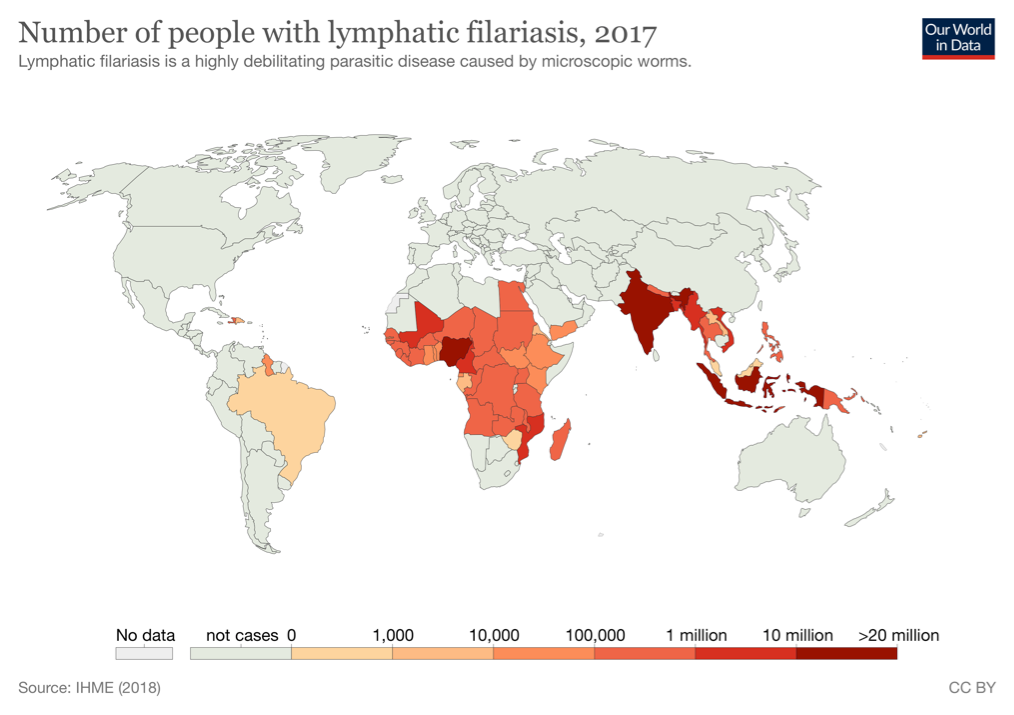The information here is provided by courtesy of the Network's short online course - "An Introduction to Global Health".
What are Neglected Tropical Diseases (NTDs)?
Neglected tropical diseases are just that – neglected. They
- do not commonly giving rise to high mortality but lead to lifelong disability and misery.
- affect more than a billion people and cost the economies of low-income countries billions of dollars a year.
- are a group of communicable diseases that are caused by several different organisms including viruses, bacteria, protozoa and parasitic worms.
- affect the poor in tropical and subtropical areas.
- affect populations living in poverty, without adequate sanitation and in close contact with infectious vectors and domestic animals and livestock the most.
Diseases included under the heading "Neglected Tropical Diseases"
The original list of diseases included within the definition is continually reviewed and new diseases are added from time to time. The following are currently included in the list
- Buruli Ulcer
- Chagas disease (American trypanosomiasis)
- Dengue and Chikungunya
- Buruli ulcer
- Dracunculiasis (guinea-worm disease),
- Echinococcosis
- Foodborne trematode infections
- Human African trypanosomiasis (sleeping sickness)
- Leishmaniasis
- Leprosy
- Taeniasis/Cysticercosis
- Lymphatic filariasis (Elephantiasis)
- Mycetoma, chromoblastomycosis and other deep mycoses
- Onchocerciasis (River Blindness) Link to a You Tube clip
- Rabies
- Scabies and other ectoparasites
- Schistosomiasis (bilharziasis)
- Soil- transmitted helminthiases (intestinal worms)
- Trachoma
- Yaws (Endemic treponematoses)
One example
An example of of a Neglected Tropical Disease is Lymphatic Filariasis (Elephantiasis).
Lymphatic filariasis is commonly known as elephantiasis on account of the visual effect it has on the body. It is caused by a nematode (roundworm) parasite of the family Filariodidea. It is commonly first picked up in childhood.
The sequence of events is that
- The roundworm in an infected person produces millions of microfilariae (immature larvae of the nematode) that circulate in the blood.
- A mosquito bites the infected person and in doing so ingests blood with the microfilariae.
- Whilst in the mosquito, the microfilariae mature into their larval stage of the nematode.
- When the mosquito with the mature larvae bites someone else, the mature larvae enter the persons blood.
- The larvae migrate to the lymphatic system where they mature into adult nematodes.
- The adult nematodes then produce millions of microfilariae and so the cycle continues.
- When the larvae grow into adult nematodes in the lymphatic system, they block the flow of lymph. This causes back pressure and swelling of the area that the lymph is draining e.g. a leg, an arm. As time goes on there is more and more swelling and great restriction of movement with consequent disability - see Photo 1.
Photo 1

Elephantiasis of leg due to filariasis. Luzon, Philippines.
Public Domain Photo Credit: Content Providers: CDC/ - This media comes from the Centers for Disease Control and Prevention (Links to an external site.)'s Public Health Image Library (PHIL), with identification number #373.
The deformities and disabilities arising from the disease lead to mental, social and financial losses that contribute to stigma and poverty.
Distribution
It is a disease that particularly affects South and South East Asia, countries in Africa and also parts of South America. (Map 1)
Map 1

Prevention and Treatment of NTDs
The World Health Organisation has developed a “Roadmap for Implementation” to accelerate work to overcome the global impact of Neglected Tropical Diseases. This contains five strategies for the prevention, control, elimination and eradication of the NTDs. These are
- Preventive chemotherapy
- Intensified disease management
- Vector and Intermediate host control
- Veterinary public health at the human-animal interface
- Provision of safe water and sanitation
Further reading
WHO overview
https://www.who.int/neglected_diseases/diseases/en/
WHO Summary of the Diseases
https://www.who.int/neglected_diseases/diseases/summary/en/
WHO : Preventive chemotherapy
https://www.who.int/neglected_diseases/preventive_chemotherapy/en/
WHO : Preventive chemotherapy data portal
https://apps.who.int/gho/cabinet/pc.jsp
WHO : Crossing the Billion. Preventive chemotherapy for neglected tropical diseases
https://www.who.int/neglected_diseases/resources/9789240696471/en/
WHO : “Accelerating work to overcome the global impact of neglected tropical diseases – A roadmap for implementation
The following short videos give a very quick overview of Neglected Tropical Diseases.
- 2 minute introduction narrated by Bill Gates.
https://www.youtube.com/watch?v=sEHmXUvpHA4&feature=emb_logo
- 2 minute overview by MSF
https://www.youtube.com/watch?v=r12mYCr0G7c




